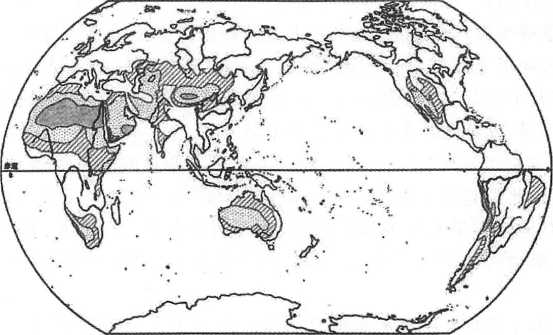Aridification
It means a long-term trend of increasing drought. Aridification is another kind of dry damage which is completely different from drought disaster. However, there is a certain relationship between aridification and dry damage, that is, with the development of drought, drought will inevitably increase and intensify. Therefore, upgrading the frequency and intensity of drought can be used as an indicator of drought. Drought is manifested in the increasing number of dry damage areas and the worsening of the disaster, which makes the original pastoral desolation, ecological degradation, and even into a desert.
With human economic development and population expansion, serious water shortages phenomenon, which has also directly led to the expansion of arid areas and the aggravation of the degree of drought. The trend of drought has become a global concern.
Distribution of arid areas(1)
Generally, the area with annual precipitation less than 250mm is called arid area, and the area with annual precipitation of 250-500mm is called semi-arid area. Arid regions in the world account for about 25% of the global land area, mostly concentrated in the Saharan Desert fringe of Africa, the Middle East and West Asia, western North America, most of Australia and northwest China. The annual rainfall in these areas is scarce and the evaporation capacity is large, agriculture relies mainly on melting snow in mountainous areas or water from upstream areas. Semi-arid areas in the world account for about 30% of the global land area, including parts of northern Africa, southern Europe, Southwest Asia, central North America and Northern China (Fig. 6-3). These areas have less rainfall and are unevenly distributed, perennial drought or even successive drought because of less rainfall and uneven distribution.
Firstly, China is located in the Asian monsoon climate region, precipitation is not only seasonal and regional, but also varies greatly from year to year. Winter-spring drought or spring drought have the greatest chance and the longest duration in all parts of the country. The frequency of drought is more than 40%, and it is 50% ~ 60% in south China and southwest China. The most serious is the continuous drought in winter and spring, which is generally the case in severe drought years.
Secondly, drought in China has obvious regional characteristics. Northeast China has less drought due to stable precipitation; the precipitation in Huang-Huai-Hai area changes greatly and the drought frequency is more in each season of the year; drought in South China mainly occurs in winter, spring and autumn; southwest China is mainly concentrated in winter, spring and summer.

Figure 6-3 Distribution of arid and semi-arid regions in the world
Comment list ( 0 )
